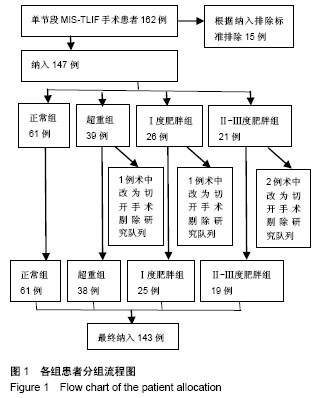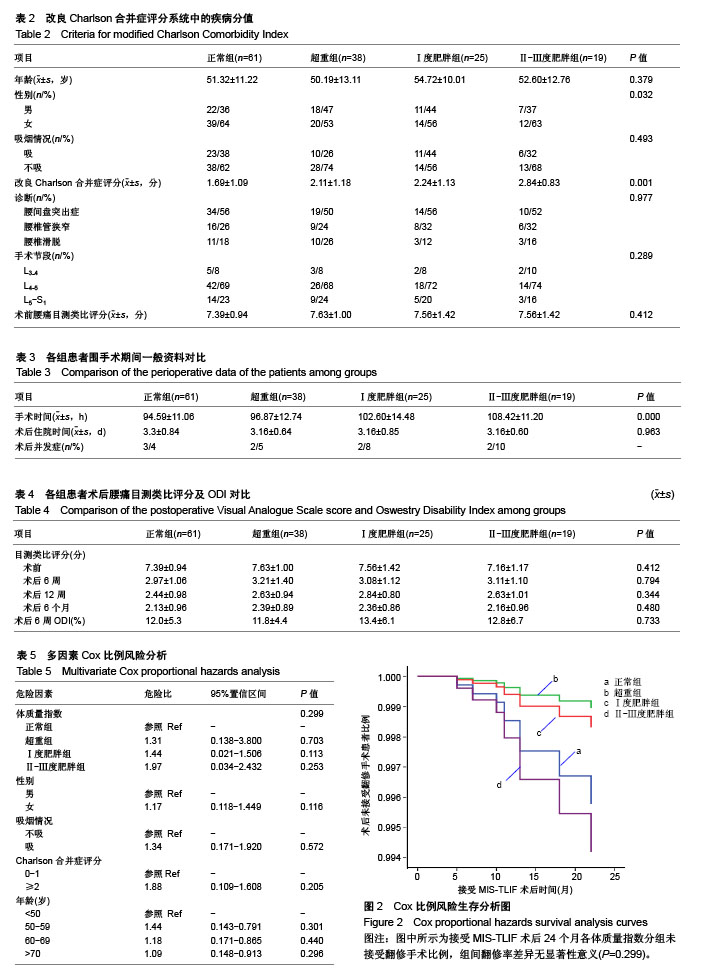| [1] Park Y, Ha JW, Lee YT, et al. Minimally invasive transforaminal lumbar interbody fusion for spondylolisthesis and degenerative spondylosis: 5-year results.Clin Orthop Relat Res.2014;472(6):1813-1823.[2] Rouben D, Casnellie M, Ferguson M. Long-term durability of minimal invasive posterior transforaminal lumbar interbody fusion: a clinical and radiographic follow-up. J Spinal Disord Tech.2011;24(5):288-296.[3] Park P, Foley KT.Minimally invasive transforaminal lumbar interbody fusion with reduction of spondylolisthesis: technique and outcomes after a minimum of 2 years' follow-up.Neurosurg Focus. 2008;25(2): E16.[4] Yusuf E, Bijsterbosch J, Slagboom PE, et al. Body mass index and alignment and their interaction as risk factors for progression of knees with radiographic signs of osteoarthritis. Osteoarthritis Cartilage. 2011; 19(9):1117-1122.[5] Heuch I, Hagen K, Heuch I, et al. The impact of body mass index on the prevalence of low back pain: the HUNT study.Spine.2010; 35(7): 764-768.[6] Buerba RA, Fu MC, Gruskay JA, et al. Obese Class III patients at significantly greater risk of multiple complications after lumbar surgery: an analysis of 10,387 patients in the ACS NSQIP database.Spine J. 2014;14(9):2008-2018.[7] Yeramaneni S, Robinson C, Hostin R. Impact of spine surgery complications on costs associated with management of adult spinal deformity. Curr Rev Musculoskelet Med. 2016;9(3):327-332.[8] 范国鑫, 汪东冬, 吴信波, 等.微创经椎间孔腰椎椎体间融合术治疗腰椎滑脱原位与复位融合的比较[J].脊柱外科杂志, 2016,14(6):335-339.[9] Charlson ME, Pompei P, Ales KL, et al. A new method of classifying prognostic comorbidity in longitudinal studies: development and validation. J Chronic Dis. 1987;40(5):373-383.[10] Deguchi M, Rapoff AJ, Zdeblick TA.Posterolateral fusion for isthmic spondylolisthesis in adults: analysis of fusion rate and clinical results. J Spinal Disord.1998;11(6):459-464.[11] Manson NA, Green AJ, Abraham EP.Elevated patient body mass index does not negatively affect self-reported outcomes of thoracolumbar surgery: results of a comparative observational study with minimum 1-year follow-up. Global Spine J.2016;6(2):108-117.[12] Owens RK, 2nd, Djurasovic M, Onyekwelu I, et al.Outcomes and revision rates in normal, overweight, and obese patients 5 years after lumbar fusion. Spine J. 2016;16(10):1178-1183.[13] Park P, Wang MY, Nguyen S, et al. Comparison of complications and clinical and radiographic outcomes between nonobese and obese patients with adult spinal deformity undergoing ninimally invasive surgery.World Neurosurg. 2016;87:55-60.[14] Rosen DS, Ferguson SD, Ogden AT, et al. Obesity and self-reported outcome after minimally invasive lumbar spinal fusion surgery. Neurosurgery. 2008;63(5):956-960; discussion 960.[15] Soroceanu A, Burton DC, Diebo BG, et al. Impact of obesity on complications, infection, and patient-reported outcomes in adult spinal deformity surgery. J Neurosurg Spine.2015:1-9.[16] Bohl DD, Ahn J, Mayo BC, et al. Does greater body mass index increase the risk for revision procedures following a single-level minimally invasive lumbar discectomy? Spine.2016;41(9):816-821.[17] Higgins DM, Mallory GW, Planchard RF, et al.Understanding the impact of obesity on short-term outcomes and in-hospital costs after instrumented spinal fusion. Neurosurgery.2016;78(1):127-132.[18] Kalanithi PA, Arrigo R, Boakye M. Morbid obesity increases cost and complication rates in spinal arthrodesis.Spine.2012;37(11):982-988.[19] McClendon J, Jr, Smith TR, Thompson SE, et al.The impact of body mass index on hospital stay and complications after spinal fusion. Neurosurgery.2014;74(1):42-50.[20] Passias PG, Soroceanu A, Yang S, et al. Predictors of revision surgical procedure excluding wound complications in adult spinal deformity and impact on patient-reported outcomes and satisfaction: a two-year follow-up. J Bone Joint Surg Am.2016;98(7):536-543.[21] Sato S, Yagi M, Machida M, et al.Reoperation rate and risk factors of elective spinal surgery for degenerative spondylolisthesis: minimum 5-year follow-up. Spine J.2015;15(7):1536-1544.[22] Smith JS, Klineberg E, Lafage V, et al.Prospective multicenter assessment of perioperative and minimum 2-year postoperative complication rates associated with adult spinal deformity surgery.J Neurosurg Spine.2016;25(1):1-14.[23] Cleveland M, Bosworth DM, Thompson FR.Pseudarthrosis in the lumbosacral spine. J Bone Joint Surg Am. 1948;30a(2):302-312.[24] Mo J, Zhang W, Zhong D, et al. Is preventative long-segment surgery for multi-level spondylolysis necessary? A finite element analysis study. PloS one.2016;11(2):e0149707.[25] Lee CH, Hyun SJ, Kim KJ, et al.Decompression only versus fusion surgery for lumbar stenosis in elderly patients over 75 years old: which is reasonable? Neurol Med Chir (Tokyo). 2013;53(12):870-874. [26] Gologorsky Y, Skovrlj B, Steinberger J, et al. Increased incidence of pseudarthrosis after unilateral instrumented transforaminal lumbar interbody fusion in patients with lumbar spondylosis: Clinical article. J Neurosurg Spine. 2014;21(4):601-607.[27] Bydon M, De la Garza-Ramos R, Abt NB, et al. Durotomy is associated with pseudoarthrosis following lumbar fusion. J Clin Neurosci. 2015; 22(3):544-548.[28] Ondra SL, Marzouk S. Revision strategies for lumbar pseudarthrosis. Neurosurg Focus. 2003;15(3):E9. |
.jpg)


.jpg)
.jpg)